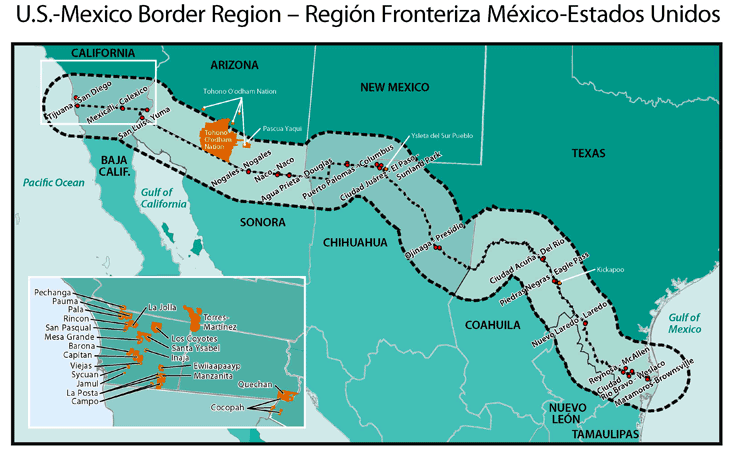Border 2025: U.S.-Mexico Environmental Program
The binational U.S.-Mexico Border 2025 Environmental Program (successor to Border 2020), is a partnership among the U.S. EPA, SEMARNAT (the Mexican federal environmental agency), the ten U.S. and Mexican border states, and the 26 U.S. border tribes. The program divides the border region geographically into four regions.
The Border 2025 Program was launched in May 25, 2021 as a partnership of U.S. EPA, Mexico’s SEMARNAT (federal environmental agency and EPA counterpart), the four U.S. border states (Texas, New Mexico, Arizona, and California), and the six Mexican border states (Tamaulipas, Nuevo León, Coahuila, Chihuahua, Sonora, and Baja California), plus 26 U.S. border tribes. Border 2025 is a successor to Border 2020 and Border 2012, which began in 2003.
Border 2025 has goals and objectives related to air quality, water quality, materials and waste management, joint preparedness for environmental response, compliance assurance, and environmental stewardship (see the Border 2025 Framework document

The Border 2025 Program divides the border region into the same four Regional Workgroups as did previous programs (Border 2020 and Border 2012), as shown in the map below. By international agreement, the border region is defined as all territory within 100 kilometers (about 62 miles) on either side of the U.S.-Mexico boundary.
Map of Border 2025 Regional Workgroups

Source: Environmental Protection Agency, U.S.-Mexico Border 2025 Program
Moving from the west to the east, one region includes California and Baja California, a second region includes Arizona and Sonora, a third region includes New Mexico, a portion of west Texas, and Chihuahua , and the fourth region includes the remainder of the Texas border region (from Big Bend to the Gulf of Mexico), Coahuila, Nuevo León, and Tamaulipas.
The Border Affairs team of the Texas Commission on Environmental Quality assists EPA's satellite office in El Paso in the third of those four workgroups.
The fourth workgroup, commonly referred to as the Four-State Regional Workgroup, has a more complex structure because of its geographical size and the number of local governments involved. In this region, the TCEQ's Border Affairs staff in Harlingen and Laredo works closely with EPA's Region 6 office in El Paso, plays a major role in organizing numerous committee meetings within the region, and collaborates with the EPA in maintaining the Four-State Regional Workgroup web site.
For additional information regarding the Border 2025 program, see the EPA Border 2025 web site.
